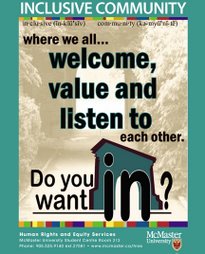
Prepared for Wendy Hounsham, TESL9005 Methodologies, Niagara College, December 8, 2006.
Ah, the love of learning ! I love learning and being in a learning environment, including a classroom. I also love language and words. What better way to enhance that love than to share it with others ? I also assume that students love to learn, and if they don’t, that the extrinsic value and intrinsic enjoyment of learning can be revealed by presenting learning in a manner that meets learners’ needs – both cognitive and affective. Consequently, my goal is to assist students who have chosen to study English as a second language to achieve communicative competence.
Respect for learners and adoption of a student-centered philosophy is vital to student success. Learning takes place within the student and that is where as language teachers we must begin. Cognitivist theories and Noam Chomsky’s confidence in children’s innate ability to acquire the language of their environment reflect a respect for the individual and her innate ability to learn (Lightbrown & Spada, 2006, Chapter One) (Zimbardo). Stephen Krashen’s Monitor Model hypotheses (Lightbrown & Spada, 2006, p. 35 – 38) regarding second language learning also reflect students’ innate ability to learn, to monitor their own learning, and to learn in a natural developmental sequence. Krashen demonstrates that as teachers and interlocutors we have an important role to play in modifying our instruction to provide comprehensible input, to provide meaningful communicative experiences, and to incorporate considerations regarding a learners’ affective filter. Regardless of the quality of instruction a learner is exposed to, his affective filter dealing with anxiety, motivation, needs, and language ego can prevent learning. Rather than addressing only a learner’s cognitive needs, teaching the “whole person” and developing strategies to address affective variables is necessary to successful language learning. Krashen’s focus on meaning rather than language form, Swain’s contribution of ideas around comprehensible output, and Vygotsky’s contribution of sociocultural ideas concerning the interaction of the learner and interlocutor (Lightbrown and Spada, 2006, pp. 20, 47,48) laid the ground work for today’s predominant focus, which I too adopt, on communicative language learning - learning through authentic purposeful communication.
Respect for student diversity, in its broadest sense, is fundamental. This includes diversity of learning styles and abilities, gender, age and culture.
In 1983 I heard Professor Robert Seim, of the University of Waterloo, discuss research he had conducted with 400 Kindergarden students. Typically teachers in his study felt that if they taught to the “average” child they were effectively reaching the largest percentage of their class. Seim found however that one third of the class had difficulty learning and that another one third of the class were above average in their abilities. Therefore by teaching to the average child, the teacher was in effect reaching only one third of her class. By diversifying her teaching techniques she could better meet the varied learning needs, styles and abilities of all her students (See also Brown, 2001, p. 154).
Ah, the love of learning ! I love learning and being in a learning environment, including a classroom. I also love language and words. What better way to enhance that love than to share it with others ? I also assume that students love to learn, and if they don’t, that the extrinsic value and intrinsic enjoyment of learning can be revealed by presenting learning in a manner that meets learners’ needs – both cognitive and affective. Consequently, my goal is to assist students who have chosen to study English as a second language to achieve communicative competence.
Respect for learners and adoption of a student-centered philosophy is vital to student success. Learning takes place within the student and that is where as language teachers we must begin. Cognitivist theories and Noam Chomsky’s confidence in children’s innate ability to acquire the language of their environment reflect a respect for the individual and her innate ability to learn (Lightbrown & Spada, 2006, Chapter One) (Zimbardo). Stephen Krashen’s Monitor Model hypotheses (Lightbrown & Spada, 2006, p. 35 – 38) regarding second language learning also reflect students’ innate ability to learn, to monitor their own learning, and to learn in a natural developmental sequence. Krashen demonstrates that as teachers and interlocutors we have an important role to play in modifying our instruction to provide comprehensible input, to provide meaningful communicative experiences, and to incorporate considerations regarding a learners’ affective filter. Regardless of the quality of instruction a learner is exposed to, his affective filter dealing with anxiety, motivation, needs, and language ego can prevent learning. Rather than addressing only a learner’s cognitive needs, teaching the “whole person” and developing strategies to address affective variables is necessary to successful language learning. Krashen’s focus on meaning rather than language form, Swain’s contribution of ideas around comprehensible output, and Vygotsky’s contribution of sociocultural ideas concerning the interaction of the learner and interlocutor (Lightbrown and Spada, 2006, pp. 20, 47,48) laid the ground work for today’s predominant focus, which I too adopt, on communicative language learning - learning through authentic purposeful communication.
Respect for student diversity, in its broadest sense, is fundamental. This includes diversity of learning styles and abilities, gender, age and culture.
In 1983 I heard Professor Robert Seim, of the University of Waterloo, discuss research he had conducted with 400 Kindergarden students. Typically teachers in his study felt that if they taught to the “average” child they were effectively reaching the largest percentage of their class. Seim found however that one third of the class had difficulty learning and that another one third of the class were above average in their abilities. Therefore by teaching to the average child, the teacher was in effect reaching only one third of her class. By diversifying her teaching techniques she could better meet the varied learning needs, styles and abilities of all her students (See also Brown, 2001, p. 154).
Students come to the classroom with a vast multiplicity of learning styles, personality types and intelligences. Whether students are field independent or field dependent, right brained or left brained, reflective or impulsive, whether their preferred learning style is auditory, visual, or kinesthetic-tactile, whether they have a tolerance for ambiguity or not, whether their personality type is extraverted or introverted, sensing or intuitive, thinking or feeling, judging or perceiving, whether their main area of intelligence is bodily-kinesthetic, intrapersonal or interpersonal, linguistic, logical-mathematical, musical, spatial, naturalist, existential or a combination, whether students study in spurts or get into “the zone” - we must be able to reach all students !!
This success can best be achieved by developing multi-sensory and metacognitive strategies, using a broad repertoire of teaching techniques and materials, and being able to draw upon them routinely in a variety of teaching situations. Personally I am drawn to aspects of the Direct Method, TPR, Communicative Language Teaching and Paulo Freire’s Participatory Approach (within consideration of confidentiality and personal boundaries), but feel that a principled eclectic approach to teaching (Larsen-Freeman, 2000, p. 183) has the greatest chance of meeting the individual needs of all students.
Further to our discussion of student diversity, gender must also be a consideration. Gender equity can be approached by simply being conscious to call upon male and female learners equally, using inclusive gender neutral language, and considering obligations outside of the classroom when setting and negotiating deadlines. Age is a factor whether instructing children, learners who have passed the Critical Period, and mixed age classes. In learners past the Critical Period, instructors may tie course goals to academic skills and broader cognitive learning abilities. A consideration of age can be helpful with something as simple as selecting culturally appropriate resource materials, such as music.
In any classroom an awareness of ethnocultural diversity is crucial. We can approach cultural diversity from a simple model of enrichment and incorporate multiculturalism into lesson content. Or we can go further, and approach cultural diversity from a model of empowerment and incorporate anti-racism principles into our curricula and learning environments. Broadly speaking, an awareness of the power dynamic between Canada’s dominant culture and those who have been traditionally marginalized can motivate us as instructors to be consciously inclusive and empowering in our teaching relationships with learners and fellow professionals. On a personal note, having experienced discrimination as a foster child I am cognizant of the potential for misuse of power and have developed empathy for people, particularly the vulnerable, and a desire for equitable outcomes. Simple examples of both models manifest themselves in such everyday concerns as assignment and exam scheduling. In the same manner that Canada’s Christian majority would not wish to have to choose between writing an exam or celebrating Christmas, it is important to leave culturally and spiritually significant dates such as Divali, Eid, Rosh Hashanah, Yom Kippur and Chinese New Year open.
Further to our discussion of student diversity, gender must also be a consideration. Gender equity can be approached by simply being conscious to call upon male and female learners equally, using inclusive gender neutral language, and considering obligations outside of the classroom when setting and negotiating deadlines. Age is a factor whether instructing children, learners who have passed the Critical Period, and mixed age classes. In learners past the Critical Period, instructors may tie course goals to academic skills and broader cognitive learning abilities. A consideration of age can be helpful with something as simple as selecting culturally appropriate resource materials, such as music.
In any classroom an awareness of ethnocultural diversity is crucial. We can approach cultural diversity from a simple model of enrichment and incorporate multiculturalism into lesson content. Or we can go further, and approach cultural diversity from a model of empowerment and incorporate anti-racism principles into our curricula and learning environments. Broadly speaking, an awareness of the power dynamic between Canada’s dominant culture and those who have been traditionally marginalized can motivate us as instructors to be consciously inclusive and empowering in our teaching relationships with learners and fellow professionals. On a personal note, having experienced discrimination as a foster child I am cognizant of the potential for misuse of power and have developed empathy for people, particularly the vulnerable, and a desire for equitable outcomes. Simple examples of both models manifest themselves in such everyday concerns as assignment and exam scheduling. In the same manner that Canada’s Christian majority would not wish to have to choose between writing an exam or celebrating Christmas, it is important to leave culturally and spiritually significant dates such as Divali, Eid, Rosh Hashanah, Yom Kippur and Chinese New Year open.
An awareness of culture and personal dignity may drive decisions regarding whether to use a technique such as TPR where female students, or Muslim students in Hijab, or an older male student may feel immodest jumping up and down. Specific to the linguistic aspects of culture, some familiarity with students’ native languages is beneficial. Languages vary in the positive and negative transfer from the L1 to the L2; therefore a contrastive language analysis can greatly inform decisions regarding corrective feedback and lesson content (Swan & Smith, 2001). I am grateful to have had some experience in learning a second language as this has given me insight into the learning and affective processes second language learners’ undergo.
One must also be aware of students’ socioeconomic, physical and mental diversity. A hungry student may not be an attentive student. A student with ADHD, whether a child or adult learner, may not learn in a chaotic classroom. And a physically disabled student may not have the opportunity to learn if they can’t get through the door, see the whiteboard, or participate in methods such as TPR.
After incorporating all of the above considerations, students may still fail. Why ? Let us flip this question and ask instead, "Why do students succeed ?" I first heard this question posed by Professor Don Meichenbaum at the University of Waterloo in 1991. This paradigm has stayed with me. Why wonder why students who are not doing well, don’t do well ? Isn’t it by far more insightful to ask, “What are successful learners doing that makes them succeed ?” When my children were in elementary school I experimented with this approach. When they brought home tests and assignments I would ask them, “What did you do that caused you to be successful on this test ? What did you do that caused you to do well with this project ?” This perspective helped them to identify and re-use specific learning strategies, to build self-esteem, and to perceive themselves as successful learners. Therefore I found the studies of a “good language learner” (Rubin 1975, Neil Naiman 1995) fascinating ! Guiding students to study their own language learning characteristics and encouraging them to employ Naiman’s characteristics of a “good language learner” has wonderful potential for student success.
All of the above requires hard work and commitment. It is the role of the learner, with assistance where needed, to identify their learning needs, to come to the classroom prepared to learn, to be an active participant in their own learning, to develop their own repertoire of learning strategies, to complete assignments, and to be prepared for evaluation tasks such as oral and written assessments. And no matter how pleasant the student-teacher relationship or how much enjoyment is generated inside a classroom, to practice language and risk-taking in authentic communicative language situations outside the classroom.
Effective lessons take time and thought to prepare. It seems apparent that effective language instructors must be willing to work hard, to come to class prepared, to be organized and resourceful, have superior interpersonal skills, continuously upgrade their knowledge, and to have an approach that is dynamic and ever evolving.
Together, a “good language teacher” (Brown, 2001, p. 429) and students who have a strategic investment in their own learning (Brown, 2001, p.208) have the immense potential and satisfaction of reaching our ultimate goal - learners’ communicative competence.
Susan Howard-Azzeh http//:suzansesl.blogspot.com/
REFERENCES
Brown, H.D. (2001) Teaching by Principles, An Interactive Approach to Language Pedagogy (2nd ed.). New York: Pearson Education Limited.
Larsen-Freeman, D. (2004) Techniques and Principles in Language Teaching (2nd ed.).
New York: Oxford University Press. In-text (Larsen-Freeman, 2004, p. 14)
Leech, G., & Svartvik, J. (2002) A Communicative Grammar of English (3rd ed.). New York: Longman. In –text (Leech & Svartvik, 2002)
Lightbrown, P., Spada, N. (2006) How Languages are Learned (3rd ed.). New York: Oxford University Press.
Meichenbaum, Don (1991) Lecture: The Exceptional Individual, University of Waterloo.
Seim, Robert (1983) Lecture: Exceptional Children, University of Waterloo.
Swan, M. & Smith, B. (2001) Learner English: A teacher’s guide to interference and other problems (2nd ed.). Cambridge: Cambridge University Press.
Zimbardo, P. Video: Language Development, Discovering Psychology.
Video: Optimizing Intelligences. Howard Gardner, Daniel Goldman, Mihaly Csikszentmihalyi.
One must also be aware of students’ socioeconomic, physical and mental diversity. A hungry student may not be an attentive student. A student with ADHD, whether a child or adult learner, may not learn in a chaotic classroom. And a physically disabled student may not have the opportunity to learn if they can’t get through the door, see the whiteboard, or participate in methods such as TPR.
After incorporating all of the above considerations, students may still fail. Why ? Let us flip this question and ask instead, "Why do students succeed ?" I first heard this question posed by Professor Don Meichenbaum at the University of Waterloo in 1991. This paradigm has stayed with me. Why wonder why students who are not doing well, don’t do well ? Isn’t it by far more insightful to ask, “What are successful learners doing that makes them succeed ?” When my children were in elementary school I experimented with this approach. When they brought home tests and assignments I would ask them, “What did you do that caused you to be successful on this test ? What did you do that caused you to do well with this project ?” This perspective helped them to identify and re-use specific learning strategies, to build self-esteem, and to perceive themselves as successful learners. Therefore I found the studies of a “good language learner” (Rubin 1975, Neil Naiman 1995) fascinating ! Guiding students to study their own language learning characteristics and encouraging them to employ Naiman’s characteristics of a “good language learner” has wonderful potential for student success.
All of the above requires hard work and commitment. It is the role of the learner, with assistance where needed, to identify their learning needs, to come to the classroom prepared to learn, to be an active participant in their own learning, to develop their own repertoire of learning strategies, to complete assignments, and to be prepared for evaluation tasks such as oral and written assessments. And no matter how pleasant the student-teacher relationship or how much enjoyment is generated inside a classroom, to practice language and risk-taking in authentic communicative language situations outside the classroom.
Effective lessons take time and thought to prepare. It seems apparent that effective language instructors must be willing to work hard, to come to class prepared, to be organized and resourceful, have superior interpersonal skills, continuously upgrade their knowledge, and to have an approach that is dynamic and ever evolving.
Together, a “good language teacher” (Brown, 2001, p. 429) and students who have a strategic investment in their own learning (Brown, 2001, p.208) have the immense potential and satisfaction of reaching our ultimate goal - learners’ communicative competence.
Susan Howard-Azzeh http//:suzansesl.blogspot.com/
REFERENCES
Brown, H.D. (2001) Teaching by Principles, An Interactive Approach to Language Pedagogy (2nd ed.). New York: Pearson Education Limited.
Larsen-Freeman, D. (2004) Techniques and Principles in Language Teaching (2nd ed.).
New York: Oxford University Press. In-text (Larsen-Freeman, 2004, p. 14)
Leech, G., & Svartvik, J. (2002) A Communicative Grammar of English (3rd ed.). New York: Longman. In –text (Leech & Svartvik, 2002)
Lightbrown, P., Spada, N. (2006) How Languages are Learned (3rd ed.). New York: Oxford University Press.
Meichenbaum, Don (1991) Lecture: The Exceptional Individual, University of Waterloo.
Seim, Robert (1983) Lecture: Exceptional Children, University of Waterloo.
Swan, M. & Smith, B. (2001) Learner English: A teacher’s guide to interference and other problems (2nd ed.). Cambridge: Cambridge University Press.
Zimbardo, P. Video: Language Development, Discovering Psychology.
Video: Optimizing Intelligences. Howard Gardner, Daniel Goldman, Mihaly Csikszentmihalyi.







No comments:
Post a Comment